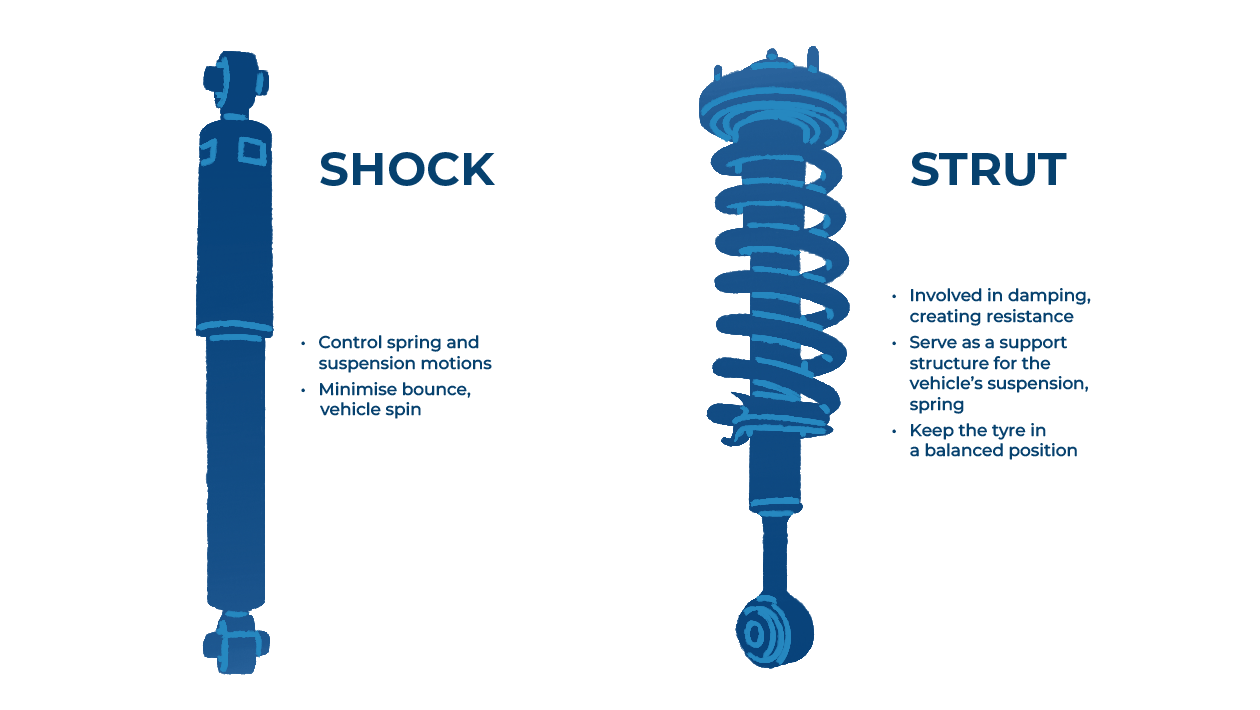Whenever you drive over a pothole or speed bump, you'll be glad that your vehicle has working shocks and struts.
Though the words shocks and struts are often used interchangeably, these are actually two different components which serve different purposes.
Both parts improve the ride quality of your vehicle, but they do so in different ways.
Shocks and struts are essential for making your vehicle travel smoothly and absorbing all of the shocks from speed bumps and uneven roads.
Read on and find out what the difference is between shocks and struts, how they are similar, and what they do.
Page Contents
What Do Shocks Do?
The main job of a shock - which is another name for a shock absorber - is the control of spring and suspension motions.
The shock absorber does this by converting kinetic energy to heat energy, which is then released through hydraulic fluid.
Shock absorbers are similar to oil pumps.
A piston is attached to the end of a piston rod working against hydraulic fluid in the pressure tube.
Hydraulic fluid can be forced through the holes in the piston, which slows down the piston, as well as spring and suspension movement.
Shock absorbers respond to changing road conditions and minimise bounce and vehicle spin, as well as brake dives and acceleration squats.
What Do Struts Do?
Like shock absorbers, struts are involved in damping, creating resistance to the forces caused by the up and down motion of your vehicle’s suspension.
Struts are made up of a truss housing that supports the suspension system, and a damping mechanism that controls the movement of springs and suspension within that housing.
The bottom of most struts is connected to the wheel assembly, which is connected to a control arm through a lower ball joint.
Like a shock absorber, a piston is attached to the end of a piston rod and works against hydraulic fluid to control suspension and spring movement for struts, too.
Unlike shocks, struts serve as a support structure for the vehicle’s suspension system and help to keep the tyre in a balanced position.
Struts also take the brunt of the vehicle's side loads.
This means that struts can have a big impact on handling and vehicle control.
What Do Shocks and Struts Have in Common?
Shocks and struts are both damping or shock-absorbing components that lessen the force transmitted from the road to the vehicle.
This affects the vehicle in several ways, including the following:
- Prevention of abnormal body and tyre motion
- Better wheel alignment
- Decreased tyre and suspension wear
- Steady braking and handling
- Reduced vehicle spin and bounce
Shocks and struts ensure that you have a comfortable journey.
They are both important parts of your vehicle's suspension system, helping to maintain the contact between your tyres and the road.
What's the Difference Between Shocks and Struts?
Shocks are individual components of the suspension system, whilst struts form a part of the chassis and suspension system.
Conventional shock absorbers do not support vehicle weight.
A proper strut unit supports the vehicle's weight by combining the strut housing, damping unit and coil spring.

How Do I Know If My Vehicle Has Shocks or Struts?
A lot of vehicles have shocks on one of the axles and struts on the other.
However, you might not always find struts on your vehicle.
Your car may have individual springs and shocks in place of struts, depending on the model.
There are a few ways to find out if your vehicle has shocks or struts.
The easiest way is to look under your vehicle.
If there are shocks installed in the vehicle, you should see them behind the tyres.
Shocks are always mounted vertically and are often shaped like a spring or a pump.
Struts are positioned horizontally and look like a wheel extension.
Given that your vehicle may have both, you should inspect both the front and rear wheels of the car.
In some vehicles the design may be different and it can be difficult to tell if your vehicle has shocks or struts.
A technician will able to advise you further if you want to know if your vehicle has shocks or struts.
How Do I Know If My Shocks or Struts Are Bad?
If your vehicle's shocks or struts need to be replaced, you will notice certain warning signs.
You may notice that your vehicle is not steady or sways at high speeds on the motorway.
If your vehicle leans to one side when taking a bend, this is another sign that the shocks or struts are bad.
Under heavy braking, you may notice that the front end of your vehicle drops more than usual.
You may only notice this if you have to slam on the brakes.
If you notice a wavy pattern in your tyre tread this can indicate that the tyre is not making contact with the road as it should.
Lastly, leaking fluid on the exterior of the shocks or struts can indicate that a seal has broken and important internal fluids are leaking.
How Long Do Shocks and Struts Last?
Shocks and struts should last about 50,000 to 100,000 miles.
This estimate can vary depending on how often you use your car and the type of roads you drive on.
You can compare the cost of shock and strut replacements near you using BookMyGarage.
Simply enter your vehicle reg and postcode into the booking tool below to get started.








No comments yet
Leave a comment